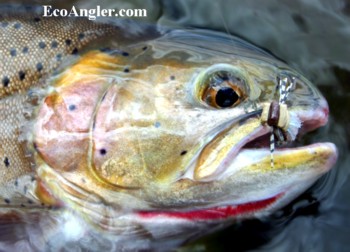Colorado River Cutthroat
During the breeding season, the Colorado River cutthroat trout (O.c. pleuriticus) is a striking crimson color along the lateral line, ventral surface, and gill covers, often with equally striking shades of orange and golden yellow laid over a yellowish or brassy background color (see above photo).
These colors become darker with age. Juveniles and non-breeding adults typically have white bellies which gradually take on color as fish increase in size (Behnke 1979 and 1992, Smith 1984). A variety of forms of Colorado River cutthroat have been observed, with specimens from isolated populations showing widely varying patterns of coloration and spotting, reflecting long-standing geographic isolation. The spotting pattern of fish from the uppermost Green River system, for example, is more typical of interior cutthroat trout in general --pronounced, rounded spots no larger than the pupil of the eye, concentrated on the caudal peduncle and above the lateral line anterior to the dorsal fin.
Alternately, fish from the Yampa River Basin, farther to the east and originally abutting the Continental Divide, more closely resemble the greenback cutthroat trout, with spots larger than the pupil of the eye (Binns 1977; Behnke 1979). Historical accounts indicate individual Colorado River cutthroat were commonly as large as 20 lbs.(Benke 1979), whereas most adult fish today are under 5 lbs. because of reduced habitat quality.

Historic Distribution
Behnke (1992) considered the range to include all accessible cool waters of the upper Colorado River drainage, including the Green, Yampa, Gunnison, Dolores, San Juan, Duchesne, and Dirty Devil rivers. By the 1970s, this distribution had been drastically reduced (Behnke and Benson 1980).
Diet
Colorado River cutthroat, like other cutthroats, are known to be insectivorous. Young et al. (1997) found that aquatic invertebrates comprised a majority of the Colorado River cutthroat trout's diet and midges, mayflies and caddisflies were selected in greater proportion than their availability in aquatic drift. Though terrestrial invertebrates comprised a smaller proportion of the cutthroat's diet than aquatic invertebrates diet, terrestrial Hymenoptera, Coleoptera, and Lepidoptera were all selected in greater proportion than their availability in aquatic drift (Young et al. 1997). Bozek et al. (1994) found that midges were the most abundant order in the stomachs of young of the year (YOY), juveniles and adult Colorado River cutthroat trout. Mayflies was second most common for YOY and juveniles, whereas caddisflies was second most common for adults. These findings are similar to studies of other cutthroat species. The Rio Grande cutthroat, for example, were found to feed on midge (Diptera) larvae, caddisflies (Tricoptera), and mayflies (Ephemeroptera), during the month of June, according to a New Mexico Game and Fish D. J. project performed in the 1960s (F-22-R-788, February, 1968). Another cutthroat subspecies, O. c. henshawi, were found to eat Daphnia pulex, a minute freshwater crustacean, when under 6 centimeters, while larger individuals focus on the typical benthic invertebrates (Luecke 1986). Terrestrial insects are also consumed during summer months, while other freshwater crustaceans provide supplemental food. (vid. Sublette et al. 1990). While piscivorousness has been found in other trout, including cutthroat (McCaffe 1966 and Baxter and Simon 1970), Bozek et al. (1994) found no evidence for its existence, at least in one creek.
Finally, because many aquatic invertebrates feed on leaf litter and leaves that fall into streams or in turn feed on other invertebrates that do, the food chain which supports Colorado River cutthroat is dependant on riparian vegetation. Riparian vegetation is also at least partly determinant of the numbers of terrestrial invertebrates falling into streams. Thus, riparian vegetation plays a vital role in providing food for the fish, making populations of the fish extremely susceptible to riparian degradation caused by livestock grazing and other factors.
